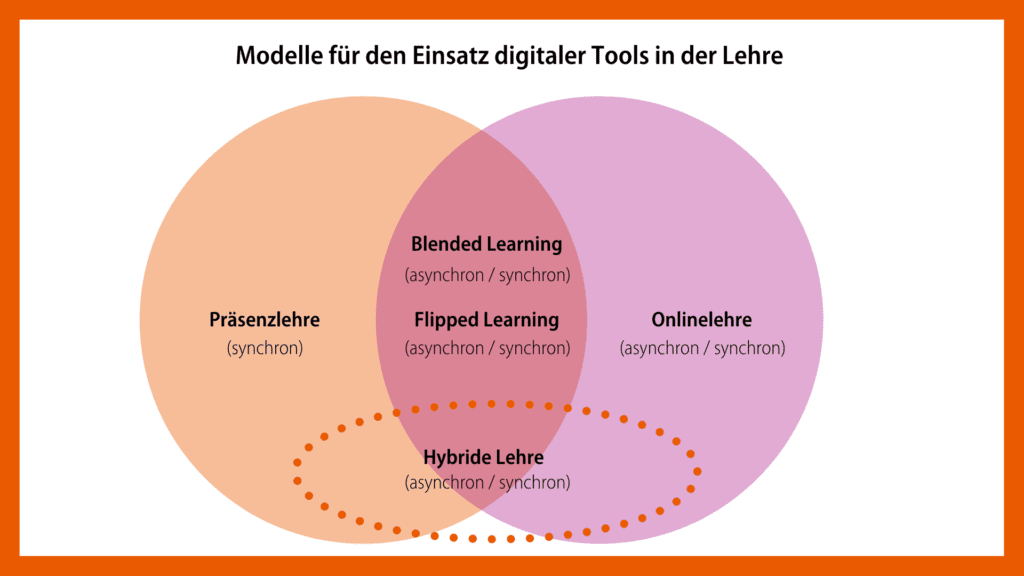Digital teaching terms
Online, hybrid, blended, flipped ... digital teaching knows many variations. For example, it can be completely online or a combination of classroom and online formats. We will illustrate the differences and provide orientation.

Which terms are there?
A course can be held …
- … in presence, i.e., exclusively on-site with spatially simultaneous (synchronous) attendance.
- … online, i.e., exclusively as an online course (synchronous and/or asynchronous).
- … blended or hybrid, i.e., in mixed form.

In a nutshell: digital teaching terms
A classroom course describes the implementation of teaching in a room at the university, where the teacher and all students are present on site in this room. Communication takes place synchronously in the university building.
An online course is held thoroughly online. The instructor and all students participate in the course from different locations using a digital device. Online teaching can be synchronous or asynchronous.
- Synchronous online teaching: instructor and students meet on recurring dates in an online session using a video conferencing tool. These sessions can include lectures by the teacher as well as individual or group work.
- Asynchronous online teaching: The teacher uploads materials and assignments to a learning management system so that students can work on them individually as a self-study unit. This can be done in both individual and group work.
Synchronous and asynchronous online courses can also be combined. This means that students complete assignments and study materials asynchronously, in addition to participating in scheduled online sessions.
Online – Didactic Suggestions
Further information and recommendations can be found here:
Blended learning combines online and classroom teaching, which can involve both asynchronous and synchronous online elements. Blended learning formats usually take place in alternating cycles – i.e., one week online, one week offline. Online learning phases may include online sessions, online group work, or self-study phases.
Blended – Didactic Suggestions
Further information and recommendations can be found here:
- Dossier Blended Learning (Hochschulforum Digitalisierung) (German)
- Blended Learning (Universität Bochum) (German)
Flipped Classroom refers to a specific variant of blended learning in which knowledge transfer and application or practice are, so to speak, interchanged. Outside of the classroom, students acquire knowledge independently using learning materials. These include, for example, videos, podcasts, texts, or recordings of courses. The advantage of the Flipped Classroom is that the shared attendance time can be used to deepen and apply what has been learned, to discuss and reflect on exceptions, and to clarify open questions.
Flipped – Didactic Suggestions
Further information and recommendations can be found here:
- Materialien Flipped Classroom (TH Köln) (German)
- Gesamtszenarien: Flipped Classroom (TU Hamburg) (German)
- Inverted Classroom (Universität Bochum) (German)
The concept of hybrid teaching is not entirely transparent. It is commonly associated with the possibility for students to participate in classes both on-site and from an individual location online. However, hybrid teaching generally refers to the combination of digital and classroom teaching – so far, mostly asynchronous as a blended learning format.
Therefore, hybrid teaching includes a whole range of different settings, so that definitions also differ:
Hybrid teaching describes the combination of digital teaching and traditional classroom formats. So far, this has mostly involved asynchronous communication in the form of blended learning.
University of Greifswald
The systematic combination of physical and digital learning environments creates hybrid learning spaces that enable various forms of collaboration and cooperation and can support individualized, flexible transfer of knowledge and development of competencies.
Project HybridLR (TH Cologne/ Leibniz-Institut für Wissensmedien (IWM) Tübingen)
There is widespread agreement that hybrid teaching (like blended learning) refers to a mixture (hybrid = blended = mixed) but without a consensus on the definition.
Prof. Dr. Gabi Reinmann (University of Hamburg)
To summarize:
Hybrid teaching describes …
- … a mixture of digital and analog teaching.
- … the combination of physical and digital learning environments.
Hybrid teaching enables…
- … individualized, flexible competence development.
- … a simultaneous and equal participation.
- … various forms of collaboration and cooperation.
Hybrid – Didactic Suggestions
Further information and recommendations can be found here:
- Hybride Lehrszenarien (e-teaching.org) (German)
- Hybride Lehre – Empfehlungen (Hochschule Rhein-Main) (German)
- Hybride Lehre – Merkblatt (Fachhochschule Bern) (German)
Any questions?
Feel free to contact us by mail to lehrpfade@th-koeln.de!
Header-Image: © Dzmitry/stock.adobe.com



